Trail Run Hub: Top 3 High Traction Trail Running Shoes For 2022
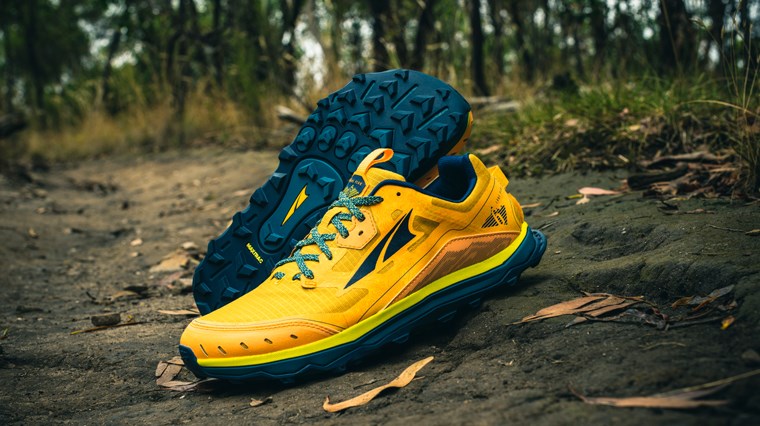
When we talk about the differences between trail running shoes vs road running shoes, one component stands out above all else – traction. Traction can make or break a trail running shoe – making the difference between enjoying sure-footed stability on a steep slope, or slip-and-sliding as you scramble over the edge.
Not only is it a matter of running confidently, it’s a matter of your safety and protection. Traction counts.
In this in-depth shoe review by Sportitude Running, we’re going to put the spotlight on our top 3 high traction trail running shoes for 2022 – the Salomon Speedcross 5, Saucony Endorphin Trail and Altra Lone Peak 6. Flip these trail running shoes upside down and you can see… and feel… how these leading running shoe brands have addressed the challenge of delivering tacky, adventure-ready grip in different and innovative ways.
Sometimes it’s not enough to simply look at the difference between trail running and road running, but to consider the variety of surfaces you may encounter off-road – from densely-packed dirt to loose gravel and slushy snow, to deep and unforgiving mud. Some trail running shoes are more versatile in the traction they provide, whereas others specialise in conquering a particular type of surface.
In this review we’re going to do a breakdown of the engineering components of each trail shoe being the upper, midsole and outsole to determine whether they could be the best trail running shoe for you or a valuable addition in your shoe rotation as you take your fitness off-road.
Salomon Speedcross 5: Ultra-reliable traction on technical terrain
Overview
The Salomon Speedcross 5 is a specialty trail running shoe – with a mission to make easy work of aggressive terrain by providing high levels of traction. There’s really no doubt that this fits in the top 3 high traction trail shoes of the year – being extremely reliable on rough terrain and providing the stability that a lighter or faster trail shoe lacks.
From the ground up Salomon have prioritised comfort, making the Speedcross 5 a top choice for hiking and trail running over long distances. It particularly flows into its element when conditions aren’t ideal. We’re talking about slippery rocks, snow and deep, slushy mud that would have any other trail shoe running the other way. Soft, natural grounds in particular are where this off-roader outcompetes the pack.
It’s this ‘super power’ to conquer a variety of natural terrain while reducing your risk of twisting an ankle or face planting in mud that makes the Salomon Speedcross 5 not only trail-worthy – but a motivational ride to explore more and adventure higher and further.
Upper
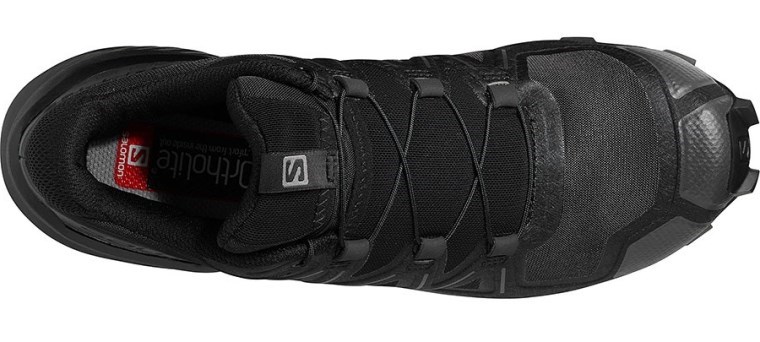
In all honesty, the Salomon Speedcross 5 is not a lightweight trail running shoe. As the running shoe world evolves, the demand for lighter and lighter shoes across all categories has increased over the years, but the Salomon Speedcross 5 stays true to its form and function - prioritising protection over lightness.
Nevertheless, the specs on paper essentially aren’t important. What matters most is how the shoe feels when you’re putting to work – and with a glove-like fit that offers a balance of snugness and freedom, that is sleeker in the right places, it never feels overly heavy or like a burden on your feet. It does its job - and it’s bound to surprise you.
The forefoot is significantly broader than previous members of the Speedcross family, enabling your forefoot to expand naturally on your longer runs and allowing your toes to splay to take full advantage of their biomechanical function to provide stability.
By no means does this mean it feels sloppy on the foot. In fact, the fit is very secure and customisable. We can attribute the foot-hugging fit to the SensiFit upper construction working in harmony with the lacing system. If the fit was sloppy, it’d be an entirely different story, but pairing a heavier weight for protection with a precise, natural-feeling fit just works – pure and simple.
You may look at the lacing system and question whether these ultra-thin laces would cause targeted pressure where they hug across the instep. To lift your concerns, the pressure is disturbed evenly thanks to the well-padded tongue.
The QuickLace system is very effective and quick (as advertised), offering a tie-free fit with one-pull tightening to easily secure the locking mechanism in place. It captures and holds the tension exactly where you need it for a distraction-free, supportive fit without loosening when the terrain gets tough, steep or ultra-technical.
The lace pocket provides an out-of-the-way home for excess laces so they don’t get snagged on by twigs or roots. The toe guard and rubber side walls reinforce the protection where needed to prevent your feet taking a beating on the technical terrain that this trail running shoe simply loves to eat up.
Let’s dive into the external heel counter because Salomon has given it a full overhaul. The heel counter is plusher and offers more height than its predecessor to hug firmly to your rearfoot and protect the Achilles tendon, providing seatbelt-like security for your feet. This means you’re less likely to be scrambling down steep descents with your feet slipping forward. Your heel is supported left, right and back for a solid fit. Keep in mind with the padded tongue and heel counter, this trail shoe isn’t particularly quick-drying as this plush material tends to hold water, but it is extremely comfortable. An Ortholite sockliner elevates the comfort even further.
The upper material itself is surprisingly soft and flexible, providing protection without being overly rigid. Salomon has the balance between snug-fitting and relaxed spot-on. The welded, stitch-free upper adapts seamlessly, both to the terrain and to your stride as you make slight adjustments to the way you move to accommodate the changing conditions of the ground beneath your feet.
As trail blazers know, there’s little consistency in running surfaces when you’re taking your fitness off-road. With this in mind it also features triangular overlays to provide an element of lateral stability because unlike road running, you’re not necessarily going to be running in a straight line on the trail.
You may be concerned that a softer upper material means a less protective upper, but Salomon has got it right with tightly woven mesh. It not only provides a barrier against natural debris from entering or puncturing the upper, but delivers an element of warmth.
In terms of the season, this trail running shoe is best suited to winter or cooler conditions with the tightly woven mesh being relatively breathable, but not quite offering the level of breathability you need for scorching and sweaty summer runs in Australia.
Midsole
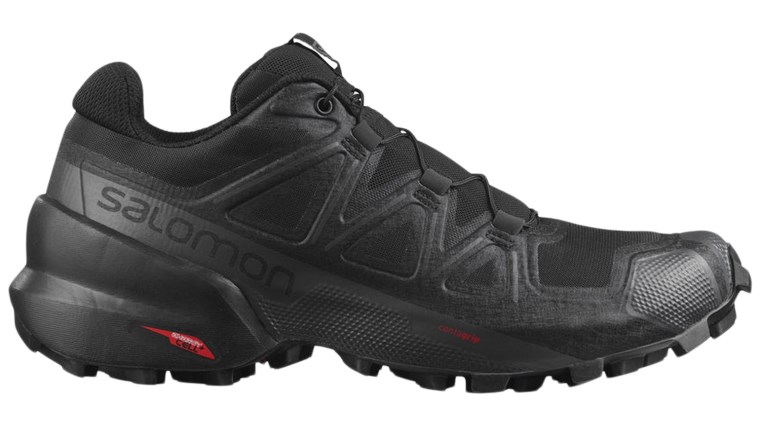
Protection and comfort are two key criteria of trail running shoes. Depending on what you want out of your trail running shoes, you may find that some manufacturers lean too deeply into this by gearing you up on a high stack with mountains of cushioning beneath the foot. This can protect your feet from taking a beating on rugged terrain, but there’s a risk of ground feel becoming overly muted to the point you can’t rely on feedback from your feet to instinctively navigate and engage to provide stabilisation.
A little bit of sensitivity goes a long way to running in confidence, especially on technical terrain. The midsole of the Salomon Speedcross 5 has been well-thought-out to this end, giving the level of feel and feedback you need, particularly at the forefoot.
Although there’s technically no pronation support, you do feel a sense that the arch is supported without it feeling as intrusive as the previous iteration, the Salomon Speedcross 4. You know the stability is there, but it’s ‘smoother’ as to not to distract you or steal your focus away from the task at hand.
The high stack height of 30mm and heel-to-toe offset of 10mm is a winning formula for luxurious comfort and protection on the feet when paired with the right runner, catering to a midfoot or heel striker. A forefoot striker would likely find this jacked-up height obtrusive and benefit from a lower, more natural drop. When slowing to a hiking pace, this combination provides smooth transitions and allows you to extend your stride length.
The midsole isn’t as soft when compared to a high mileage road shoes because it’s expected that if you’re wearing the Salomon Speedcross 5, you’re already running on a soft surface. On soft grounds, very compressive, marshmallow-like cushioning can be a disadvantage rather than a benefit because you need a degree of firmness to stay stable on the platform.
The Energy Cell+ midsole is resilient against the challenges treacherous, off-road terrain presents and in terms of plushness, is a middle ground between minimalist and max cushioned shoes. It provides a springy sensation and absolves the need for a rock plate, with protection packed into this energy-returning foam and the outsole rubber itself.
Outsole
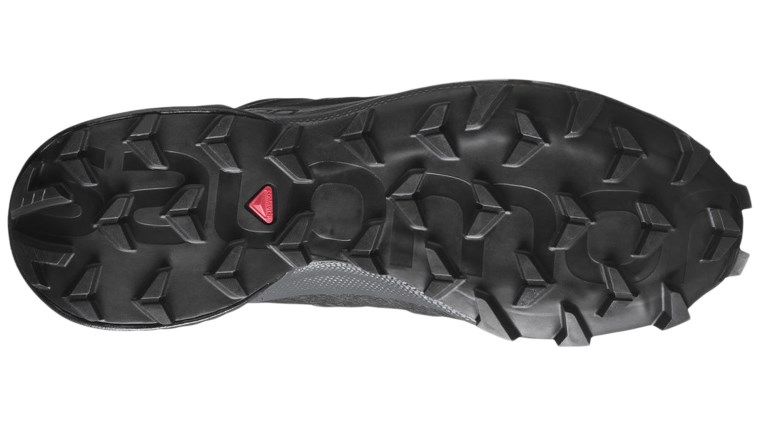
Aggressive traction is the Salomon Speedcross 5’s major selling point – specialising in conquering technical, rocky and mountainous terrain like it’s cruising on clouds. Staying sure-footed on natural terrain comes effortlessly, both for uphill running and daring descents. It conquers soft dirt trails, cross-country courses and uneven terrain as if they were as smooth as road. Even biting into snow, deep mud or staying stable on wet rock which is a challenge for most trail running shoes doesn’t present even an itch of a problem. How is the traction this good?
Salomon set you up with a soft rubber in the outsole made of Salomon’s Contagrip TA. Being more pliable than harder rubbers, it offers tacky grip to stick confidently and surely onto multiple terrain types during your off-road adventures. Even with a narrower midfoot area decreasing the surface area of the shoe that’s in contact with the ground, the ‘suction’ these lugs provide keeps you stable when it’s slippery underfoot.
In saying that, this is not a hybrid trail-road shoe. With rubber this soft and sticky, the ‘road is lava’ so to speak – and will wear out this soft but super effective rubber in no time. Wear it only on natural surfaces and for its intended purpose and you’ll find yourself enjoying technical terrain like it’s your own personal gym.
Comparing this multi-directional, chevron lug configuration next to its predecessor, the Salomon Speedcross 4, this newest model offers more prominent lugs in terms of size, depth and tackiness – making a high traction trail shoe even more grippy and confidence-inspiring. The wider spacing between these 5mm lugs helps to avoid the ‘mud pancake’ effect, where mud becomes ‘glued’ or trapped between a denser lug pattern and compromises traction.
In some trail running shoes, an aggressive lug pattern to conquer rough terrain can be felt through the trail shoe to the foot, but this isn’t an issue here as long as you avoid road surfaces. A thick, cushioned heel provides protection in this high-impact zone, providing a forgiving barrier if you misplace a step and land on a sharp stick or stone. The ground feel is less muted directly beneath the forefoot, giving you that degree of sensitivity to heighten your proprioception and stay feeling connected to the natural world beneath your feet.
SPECS
- Support: Neutral
- Upper: Mesh
- Midsole: Salomon EnergyCell+
- Heel Height: 30mm
- Forefoot Height: 20mm
- Offset / Drop: 10mm
Men
- Weight: 320g / 11.3oz
- Width: D (standard), 2E (wide)
Women
- Weight: 280g / 9.9oz
- Width: B (standard)
Saucony Endorphin Trail: Heavy on traction, protection & durability
Overview
This year we welcomed a forth shoe to the Saucony Endorphin trifecta – the Saucony Endorphin Trail or E.T to its fans. So far, this running shoe family consists of the Saucony Endorphin Shift for everyday athletes, the Saucony Endorphin Speed for tempo training and Saucony Endorphin Pro for race day and the subsequent generations of these models.
The Saucony Endorphin Pro was a clear competitor to challenge the record-breaking Nike ZoomX Vaporfly family, and you can read more about the Nike ZoomX Vaporfly 4% - the shoe that started it all - in Nike's 50th Anniversary: A Celebration Of Sport & Future Sustainability. It was exciting to see another brand throw in a ride that could be a worthy rival in speed and responsiveness.
Boasting the winning formula behind the game-changing Endorphin collection – SPEEDROLL technology for a smooth and efficient stride and responsive PWRRUN PB cushioning – hype was building for the Saucony Endorphin Trail and we were curious as to where it’d fit in as part of the popular Saucony Endorphin series. These technologies that had never been seen before in a trail shoe, have been paired with the PWRTRAC outsole that earned a name for itself for its high traction in Saucony’s off-roaders including the Saucony Xodus and Saucony Peregrine.
In this way there’s nothing entirely new about the Saucony Endorphin Trail in terms of the midsole and outsole. For the most part it takes the best of Saucony’s road shoes, the best of their trail shoes and creates a smooth and dependable ride based on this innovative blend of technologies. With a bold aesthetic and trail-ready details the upper however has a lot new to say and is by no means discreet – it was made to be seen.
Saucony set a high bar with the Endorphin series and if you were expecting a fast, light and snappy feel like the nylon-plated Saucony Endorphin Speed series or carbon-plated Saucony Endorphin Pro 3, you may be a touch disappointed when lacing up in the Saucony Endorphin Trail that is in its element when ultramarathon running. In fact, it is the heaviest trail shoe from Saucony and has earned a reputation as a bit of a ‘tank’.
However, if you’re looking for a stress-free ride on the trail with a feel that mirrors the supportive and cushioned Saucony Endorphin Shift that was designed for daily training and logging high mileage – you’ll love this.
Upper
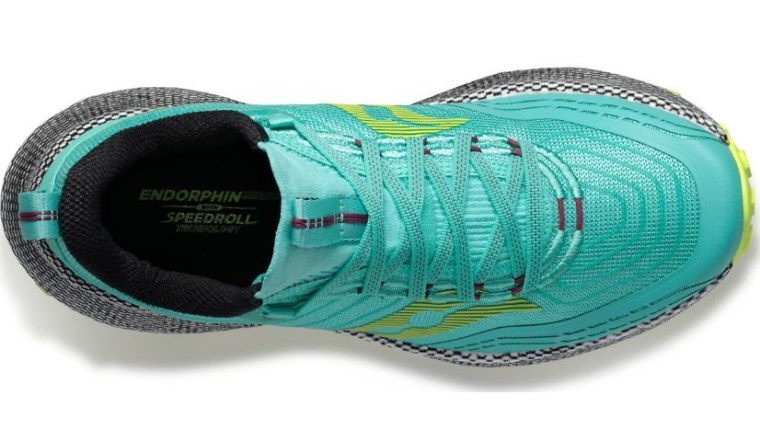
Whereas in many contemporary running shoes you’ll find there’s been a decent effort to shed non-essential weight through thinner upper materials or outsole rubber, the Saucony team have thrown this trend to make shoes lighter out the window when it comes to the Endorphin Trail. Instead, they let the Saucony Endorphin Trail be what it was born to be – protective and durable.
Of course, this means it has a fair whack of weight and bulk to it – which have caused some trial blazers to question why it’s been branded as an Endorphin at all, as the name sets up an expectation for it to be a lighter and faster shoe which is criteria it simply doesn’t meet. However the tech is certainly there as we’ll discuss in the midsole part of this review, and for the right runner, it’s the ultimate off-road partnership.
The upper is like armour for your feet – a strong barrier of dense mesh to shield your toes if you happen to collide with sharp sticks or stones. You may feel happy enough to acclimatise to the heavier weight considering the protection you get in return to run confidently and without hesitations.
Adventure-ready features like the Quick-Fit Trail Sleeve tongue prevents natural debris from entering the shoe so you won’t have to put a pause on your training to shake out small twigs or rocks. Rather than setting you up with a traditional tongue, it offers a bootie-like construction with an integrated, sewn-in tongue that helps the entire upper function in harmony, as if it were a single piece.
This tongue design makes it accommodating to a more diverse range of foot shapes, stretching to fit your midfoot comfortably. Pull tabs on tongue and heel allow you to slide in and out of these trail running shoes more easily rather than having to wrestle them on.
It creates a secure lockdown and sock-like fit with the FORMFIT technology that has been transferred over from its Endorphin cousins. As we mentioned with the Salomon Speedcross 5, a precise fit is so important when a running shoe has a heavy weight that has the potential to feel like bricks on your feet if not fitted correctly.
A more spacious forefoot may surprise runners familiar with the other members of the Endorphin series, keeping in mind this trail running shoe is designed for longer efforts, not short races.
Again, seemingly little effort has been made to reduce the weight. Compared to the thin laces of the Salomon Speedcross 5, the Endorphin Trail lacing system features thick and flat laces, and skips traditional eyelets in favour for robust, rope-like loops that the lacing weaves through.
There’s no additional eyelet to accommodate a runner's lock lace so getting that really personalised fit can be a challenge due to the stretchiness of the laces if you’re a narrower foot type, while other runners may crave a slightly more deeper and voluminous fit.
All runners will enjoy that pressure isn’t a problem with flat lacing that won’t cut into your feet and that’s stretchy to accommodate the expansion of your feet during heart-pumping ultra-runs. If you have any qualms with the laces themselves, it’s easy enough to swap them out with these running shoe laces, but the feedback of many runners praises the lacing system for its ability to both adapt and stay secure over technical terrain.
Just-right padding in the interior enhances the secure and comfortable fit around the collar and heel while durable overlays improve the overall structure. Even if you aren’t a naturally biomechanically efficient runner, this structure with external heel counter offers a degree of support and aids in locking your foot on the – let’s not sugar coat it – monstrously high platform. Sticking true to its trail-ready attitude, it features a toe bumper made from thick rubber to stay protected from natural debris.
As you may have guessed by now, the upper isn’t simple – there’s a lot going on in terms of the durability, protection and the security it provides. If you’re seeking minimalism or a trail shoe purely for hot summer runs, look elsewhere. It’s another fantastic choice for cooler weather, with an element of breathability being sacrificed for protection, so there is a risk of them turning into saunas for your feet if you insist on taking them out when the mercury climbs. Another potential inconvenience is that the material doesn’t dry fast, so if you're running in the rain or through shallow streams you may hesitate to invite this ride out.
Midsole
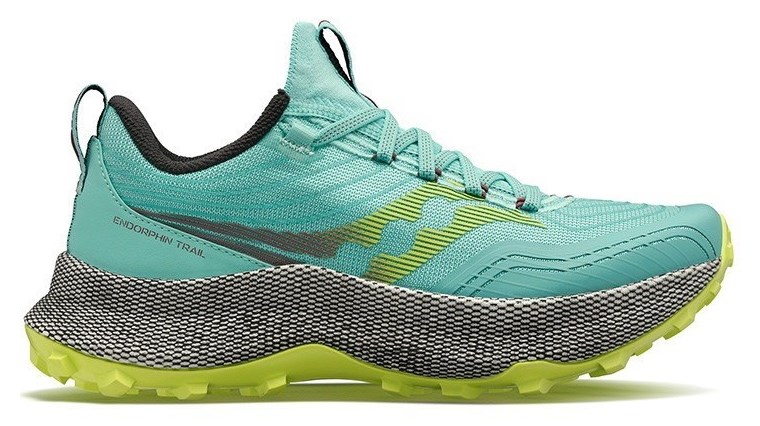
As we touched on in the intro, when the Saucony Endorphin Trail was launched the expectation was it’d be following in the fast, snappy footprints left by the Saucony Endorphin Pro or Saucony Endorphin Speed.
Directly out-of-the-box this expectation was challenged. With the name Endorphin runners imagined a sleeker, lighter trail shoe and what they got was a high stacked shoe with a personality more closely resembling the ultra-cushioned On Cloudmonster than its speed-driven Endorphin cousins.
The faster you adjust that expectation and shift it to be more in line with what the Endorphin Trail is really about – max protection like the Endorphin Shift – the faster you’ll enjoy this joy-inspiring ride for what it is, and not what you thought it was meant to be.
It features the SPEEDROLL rocker geometry with the exaggerated toe spring of its race-ready Endorphin cousins, but how does this technology translate to off-road running? SPEEDROLL technology excels at providing smooth, energy efficient forward momentum – and on the consistent nature of the road, it’s exceptional. Running in a straight line is where it really shines. If you’re thinking the trail can be dark, twisty and unpredictable, your concern is justified.
On tamer trails, SPEEDROLL technology paired with the trail shoe’s rigidity allows you to flow into your stride effortlessly, like you’re running on autopilot, and is responsible for much of the responsiveness you get out of this shoe. Encounter debris-littered trails that require you to dodge gnarled roots or sidestep over small boulders and it can feel a little overengineered and awkward, not catering to lateral movement as smoothly as you’d like.
This doesn’t mean you have to work up a sweat if you run into slight turns or uneven ground for a time, but if you are seeking to run on predominantly wild and unmaintained trails the performance of SPEEDROLL can be a mild disadvantage rather than an asset. Nevertheless, the forward geometry does cater well to flat grounds and equally brings out the trial shoe’s ‘climbing’ instincts – motivating you to gain height on challenging inclines.
PWRRUN PB is Saucony’s ‘super foam’ that has made a name for itself in the Endorphin series – yet it performs and feels different in the Endorphin Trail. In the Endorphin Trail the cushioning runs from heel-to-toe and is relatively firm while lacking the carbon or nylon plate of the Saucony Endorphin Pro and Endorphin Speed respectively.
Initially the more you run in it, the more responsive the midsole seems to get – breaking in at around the 5 - 6km mark and feeling even better closer to the 30km mark - but in the Endorphin Trail its key role is protection. This we definitely can’t fault it on.
The protection is so jacked-up that you can basically bulldoze over challenging, aggressive terrain without feeling a thing. We’ll let you decide whether that’s a pro or con, because it really depends on the type of runner you are and what you want to get out of your trail running shoes. If a minimalist style that allows you to navigate trails more intuitively is a better rhythm to your beat, our top 3 lightweight trail running shoes are calling you.
Although ground feel is filtered to zero through this cushioning technology, one could argue that not all feedback is lost. This is thanks to the foam not being too soft or bouncy, which is a risky move when paired with a running shoe on a high platform as the trade-off is potential loss of stability. Don’t sweat it, because this is not the case here.
In the Endorphin Trail, PWRRUN PB is relatively firm and doesn’t ‘squish’ underfoot like softer foams. It’s more resistant to compression and less springy than the PWRRUN PB in the Endorphin Speed and Endorphin Pro, suggesting the density has been tweaked to be considerably firmer in the Endorphin Trail model. Nevertheless, it does feel energetic, resilient and stable – characteristics you want out of a trail shoe. For a softer trail shoe, the Hoka Challenger 6 ATR can offer the luxurious ride you crave. For a more responsive trail shoe, the Brooks Catamount is a worthy alternative.
Even though the Endorphin Trail is advertised as a neutral shoe, it does offer considerable stability both torsionally and from heel-to-toe in the strategic way it cradles the foot with a wide base. Being on a high, ultra-forgiving stack with a 36.5mm heel and 32.5mm forefoot height of shock-absorbing cushioning underfoot, this trail running shoe soaks up the impact forces whether uphill running, downhill running or flowing into your runner’s high on flat surfaces.
Hoka One One fans will find this stack height and low 4mm heel-to-toe drop a happy place for their feet, closely comparable to their high-stacked Hoka running shoes. In terms of the sensation underfoot, it’s a cross between the Brooks Cascadia 16 which we discussed in Top 3 Cushioned Trail Running Shoes For 2022 and Asics Trabuco Max. Both are super protective and are worth a look if you’re hunting for a trail shoe in this cushioned category.
The midsole of the Saucony Endorphin Trail is wrapped in a neat package, encased in a web-like mesh material to prevent it being exposed to trail debris that could potentially damage it from the outside.
Outsole

PWRTRAC has proven again and again to perform effortlessly in rugged environments. The PWRTRAC outsole may look different and considerably smoother than the same tech in the Saucony Peregrine family but rest assured its performance stacks up, delivering trail-ready traction to bite, stick and grip onto aggressive terrain.
Even after over 50km of enduring the toughest trail conditions, the 4.5mm chevron lugs are barely worse for wear, cementing your confidence in the trail shoe’s long lifespan. No surprises here, but these deep and prominent lugs are at home on natural surfaces – not on the road where they can feel cumbersome. Their high traction benefits are best felt during hiking and long-distance runs, where the solid grip and the rubber outsole’s durability and protection can be put to the test. The verdict is in – it gets A+ for all of the above.
They’re in their element when providing claw-like grip on muddy surfaces or gravel, rather than smooth-as-butter trails where the hardness of the rubber causes them to sit on the surface of the trail, rather than biting into it for solid grip. The lugs are positioned where you need them most at the forefoot and rearfoot of the shoe, leaving the midfoot somewhat bare - not that this is an issue.
In short, they provide aggressive traction for rough terrain that challenges you with its technical elements. The thick, full rubber coverage with its vibrant colour almost dares sharp twigs or rocks to have a go at it, but as hard as they try, none can puncture through - even without a rock plate. Skipping the rock plate is probably a smart move by Saucony as there’s plenty of rigidity without stacking more below.
Pace doesn’t come easily with the hefty weight, but if you let go of the need for speed, this thick and stiff outsole provides an ever-reliable platform for the trail – even if it does feel like it needs to ‘warm up’ before you can take full advantage of it without feeling too rigid.
The feedback from heel strikers is they’d like to see a bevelled heel in the next generation to work in harmony with the SPEEDROLL technology of the midsole. SPEEDROLL technology is focussed at the forefoot to provide an efficient stride and aggressive toe-off, but at the rear the lack of a bevelled heel can feel clunky, so some of the effect is lost. The addition of a bevelled heel would smooth out rough landings for heel strikers, providing a good foundation to kick-off the rocker-like sensation underfoot.
Depending where you land on footstrike, if you’re a midfoot striker for example, you may not bat an eyelid at the lack of a bevelled heel. It’s all about choosing the best running shoe for you - that accommodates your running stride and foot type.
Many Endorphin runners have their fingers crossed that Saucony will release a trail running shoe that conforms more closely to the fast and snappy characteristics of the Endorphin Pro or Endorphin Speed. We can’t guarantee there is a Trail Pro or Trail Speed in Saucony’s future, but if you’re happy to conquer off-road environments at a cruisy pace with ample protection and solid traction, the current Endorphin Trail will undoubtedly grow on you.
SPECS
- Support: Neutral
- Upper: Mesh
- Midsole: Saucony PWRRUN PB
- Heel Height: 36.5mm
- Forefoot Height: 32.5mm
- Offset / Drop: 4mm
Men
- Weight: 295g / 10.4oz
- Width: D (standard)
Women
- Weight: 255g / 9.0oz
- Width: B (standard)
Altra Lone Peak 6: Zero-drop, max traction
Overview
The first Altra Lone Peak launched in 2011 – boasting Altra’s signature combination of a zero-drop and wide toe box that is consistent across the brand. Over a decade on and the word ‘legendary’ has been used to describe the Altra Lone Peak family. It quickly became a cult classic among trail blazers – and we’re here to tell you how the 6th generation stacks up to its iconic reputation as an off-road all-rounder.
Zero-drop refers to the fact that there is no slope between heel and forefoot. The shoe is level - a feature that Altra calls Balanced Cushioning. You can learn more about the heel-to-toe offset and stack height of running shoes, guided by Sportitude's in-house shoe expert Josh Willoughby.
If you’re a fan of zero-drop shoes the Altra Lone Peak 6 is a worthy contender as your go-to trail running shoe – durable, breathable and accommodating for a variety of foot types, particularly wider feet. The zero-drop creates the impression that you’re wearing a minimalist shoe, but with slightly more ‘oomph’ to it, providing a blend of satisfying ground feel and protection.
Whether you’re a loyal and experienced zero-drop runner, are a beginner trail runner seeking a trail shoe that encourages a more natural posture or want a trustworthy, high traction ride in your shoe rotation, the Altra Lone Peak is well worth a look. Rotating between shoes with slight variance in heel-to-toe drop and stack height has multiple benefits, both in extending the lifespan of the shoes and in distributing stress to your feet differently to avoid overuse injuries.
If you’re keen to purchase the Altra Lone Peak as your stand-alone trail shoe, as long as you gradually transition to the zero-drop it’s unlikely you’ll have any regrets. It offers a natural-feeling ride that feels lighter than its predecessors without taking a deep dive into the barefoot world of trail shoes, like the Vivobarefoot Primus Trail 2.0.
Flat trails are where it shines in preference to steeper inclines that may have your feet aching for a higher level of support and structure over the streamlined and flexible fit. However, in saying that flat doesn’t necessarily mean smooth because the Altra Lone Peak 6 runs just as reliably on gravely and rocky grounds as on densely-packed dirt.
Whatever the trail throws at you during short to medium distances, this trail running shoe can handle it with a balance of sensitivity and protection that we can’t fault. If you’re looking for a daily trainer for off-road fitness, it ticks all the criteria from the ground up.
As running shoe specialists, it’s a difficult moment to endure when a customer realises a model that they’ve worn and loved for its entire lifespan has had a complete overhaul in the newest generation. Luckily for Altra Lone Peak runners, you can roll right from the Lone Peak 5 to the Lone Peak 6 without this concern. By no means does the newest model steer away from the features, feel or fit that you rely on, only tweaking the ride to make a good thing even better.
The Altra Lone Peak 6 has been praised by trail blazers as the best Lone Peak to date – and we’re inclined to agree.
Upper
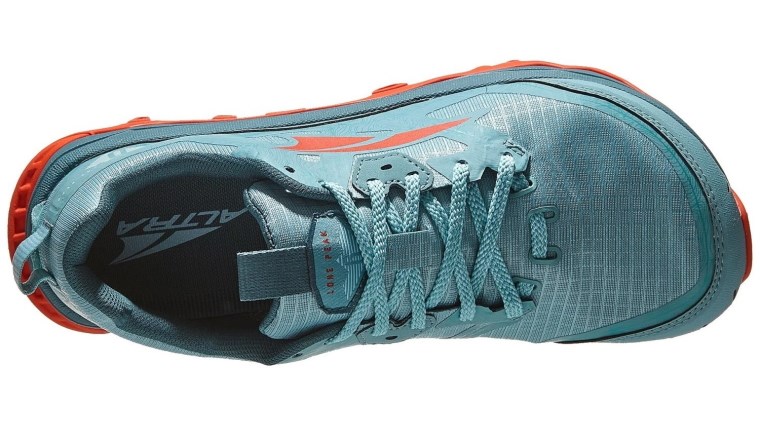
If you’re craving more wriggle room, look no further. Altra running shoes have been celebrated by runners with wider foot types and anybody that loves a spacious feel – and the Altra Lone Peak 6 lives up to that reputation and then some.
It allows you to splay your toes for stabilisation and for your feet to naturally swell as you increase distance or as the intensity climbs without feeling suffocated or restricted inside the shoe. With your feet being able to move more freely, your bones, joints and muscles are able to engage more fully – allowing them to strengthen like every other muscle that’s activated during your runs.
Stronger feet translate to less risk of injuries in the long run. If you’ve been stuck in more restrictive shoes with a pointed toe box for a long time, Altra running shoes are a real eye-opener as to what a broader fit can do for your natural running biomechanics and comfort.
Altra has 3 designations of FootShape fit – being Original, Standard and Slim. The Altra Lone Peak 6 falls under the Original category – being the widest and most accommodating. Rather than being shaped like a traditional shoe, this more natural design is foot-shaped. Keeping in mind the point where the base of your toes meet the ball of your foot is the widest part of your foot, this wider toe box is more true and honest to your anatomy compared to a shoe that tapers at the toe.
You may imagine this generous fit would have a sloppy effect as you conquer technical terrain, but Altra have got it just-right – roomier at the toes and snugger towards the midfoot and heel to function like an extension of your body. This refined midfoot fit is one of the features that stands out as an improvement from the Altra Lone Peak 5.
The secure, foot-hugging and malleable heel cup makes heel slippage a thing of the past. This may sound like a small detail but it translates to distraction-free comfort and confidence-inspiring hill climbs and descents. The heel cup provides an element of support, whereas reduced overlays across the sleeker upper lower the weight and increase flexibility without overall compromising the structure of the shoe.
When fitted correctly, not only does the wide toe box and flexibility improve your freedom, but reduces chafing and the risk of developing blisters. A narrow foot type in a wider shoe can be a problem though, as excess movement can result in blister-causing friction. Wearing technical running socks for the trail can help customise your fit.
If you find your Altra's too spacious, thicker socks like Lightfeet running socks that feature cushioning around the toe or the 1000 Mile All Terrain running socks with a Merino wool blend can help pad out a large toe box. Considering the upper mesh of the Altra Lone Peak 6 is thin and very breathable – almost too breathable for wintry conditions – a thicker sock also has the additional benefit of providing warmth.
The gender-specific lasts are fine-tuned to accommodate anatomy differences between men and women, with the women’s model featuring a midfoot and heel that’s slightly narrower, a higher instep and extended arch.
The upper material is just as quick-drying as the earlier versions of this trail shoe – so if you’re the kind of runner that loves to dive foot first through a shallow creek rather than finding an alternative route, it’s happy to get dirty with you. There’s even laser-cut perforations at the toe to help water to drain fast.
The laces themselves make a statement with a flat profile and optimal stretch for a secure yet adaptive hold on your feet. A tiny detail that’s well worth a mention is the additional eyelets, so runner’s that value a personalised fine-tuned fit with a runner's lock lace will love to lace up in this off-roader. It’s a great way to balance out the broad toe box, providing a means of really dialling in the fit and to control the distribution of pressure across the midfoot.
A gusseted tongue complements a design that offers a snugger fit in the right places. It delivers just-right, pressure-reducing padding and provides a barrier against small stones or sticks from entering. The GaiterTrap hook-and-loop tab at the heel allows you to attach a gaiter with zero inconvenience – giving you the option of extra trail-ready protection to block out water or natural debris. A discreet pull tab on the heel and more prominent pull tab on the tongue make it easy to slide in and dash out the door.
In terms of durability and protection, some runner’s found that the toe cap of previous iterations was the first feature of the upper to noticeably wear out. The toe guard in the Altra Lone Peak 6 is more durable and resilient against peeling off or wearing down. It’s also now stitched to the outsole, so you can trust it’ll hold up well against any collisions with roots or rocks.
Midsole
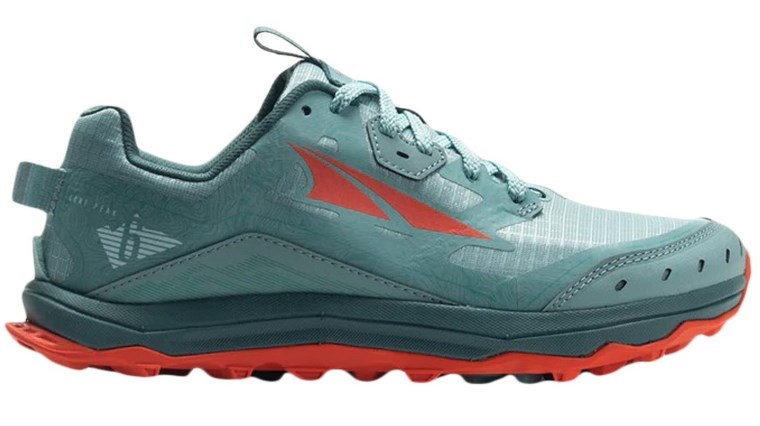
With some max cushioned trail running shoes, you may find you’ve virtually lost track of the ground with the oodles of protective cushioning underfoot – and that works for some runners that enjoy wearing a thick slab of luxury on their feet. Others prefer to feel every pebble, nook and cranny in the natural terrain underfoot, getting as close as possible to running barefoot to move more intuitively based on ground feel, increased proprioception and feedback.
The Altra Lone Peak 6 is a happy middle ground. Whereas a true barefoot shoe with a zero-drop and no cushioning can be a shock to the system for runners that aren’t familiar with it, and a max cushioned trail running shoe can make you feel disconnected to the world beneath your feet, the Altra Lone Peak 6 pairs a zero-drop with moderate cushioning. You don’t feel overly elevated off the ground like a Hoka running shoe – but of course, this is exactly the sensation Hoka fans seek out. Every specialist brand is catering to a specific feel, you just need to find what’s right for you. Sportitude Running with our RunDNA and Live Fit shoe fitting service is here to help - guiding your running shoe purchase and supporting your running journey (more on this below).
Of course, with your feet the same distance from the ground from heel-to-toe, a feature that Altra call Balanced Cushioning as we touched on earlier, pressure is applied differently to your body than if your heel was propped up higher than your toes. Many heel strikers prefer some extra height or a more jacked-up heel to protect this high-impact zone from shock, being the first point of contact with the ground.
In this way a zero-drop shoe may challenge the way you run. It'll take your feet some time to acclimatise to before it feels truly natural, and you may find your calves are sorer in your first few runs until you adapt. The reward is a more natural-feeling ride, posture and body alignment that disperses pressure more evenly.
As long as you choose shoes that fit with your running stride and biomechanics, you can achieve the proper running form for you. If you're comfortable and are not experiencing any pain while running - whether you're wearing zero-drop shoes, shoes with a high heel-to-toe offset or something in-between, it’s more about what feels right for you and your personal preference.
In terms of the stack height the Altra Lone Peak 6 sits at 25mm - a middle ground between it’s trail running cousins the Altra Superior 5 with a 21mm stack height and Altra Timp 4 with a 29mm stack height. The higher stack height of the Altra Timp 4 somewhat masks the sensation of wearing a zero-drop shoe whereas on a lower stack height you know exactly what you’re wearing which can be a good or bad thing depending on the feel you’re going for. A lower profile naturally creates a faster and more agile sensation as there is less physical shoe separating your feet and the ground.
The Altra Lone Peak 6 cradles your feet in a single-density Altra EGO foam compound for out-of-the-box comfort. It isn’t the softest or most responsive foam on the market, but it is all about balance. This level of cushioning is forgiving on your joints and knees which can take the brunt of shock when landing hard, without overly compromising on ground feel.
It’s less focussed on energy return and more on protection – plush enough for that dash from the front door to road, to trail without your feet taking a beating on the tarmac in-between. Alongside the outsole, this midsole foam earns the Altra Lone Peak 6 the badge of hybrid trail shoe with its high versatility and comfort on multiple terrain types.
Although it’s slightly springier than the previous generation, if bounce is what you’re craving you may find your fit in snappier trail running shoes like the Nike Pegasus Trail 3 that goes the extra mile to propel your stride forward. The Altra Lone Peak 6 is about comfort but isn’t about making your run easier by doing the hard work for you. Its mission is to allow you to engage your natural tools – your feet – to run stronger and more efficiently over time. We certainly have respect for them for that.
Outsole
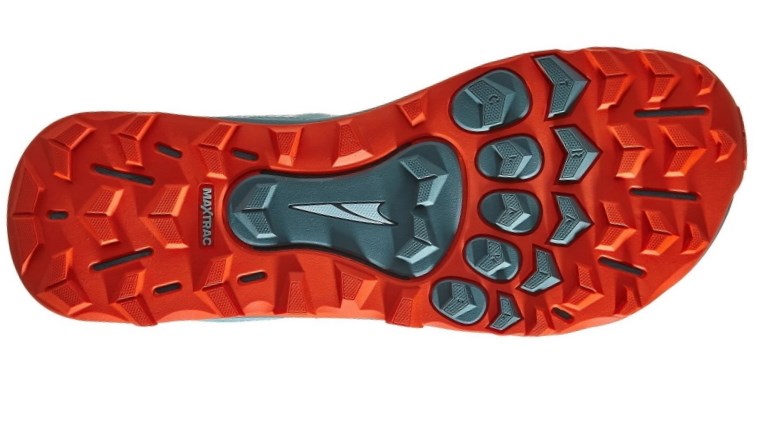
Now for the most exciting part – the outsole. Flip this trail running shoe upside down and you’ll see Altra’s TrailClaw design that remains relatively unchanged from the previous iteration.
What we love about this system is it’s designed to work with your feet. At the forefoot, you can count across the 5 rows of deep chevron lugs, with the rows being strategically placed to follow each metatarsal or toe. Essentially it’s an extension of your body’s natural stabilisers – your toes – allowing you to bite onto rugged terrain with a claw-like grip. A combination of forward-facing lugs at the front and rear-facing lugs at the back provide a winning formula for off-road traction for uphill running, downhill running and braking power as needed.
Paired with Altra's MaxTrac rubber that has a history of providing aggressive traction, this trail shoe is one to beat when dashing over soft surfaces like dirt and sand, hard surfaces like rock and even slushy surfaces like snow and mud. If you’re a runner that loves to go from door-to-trail without switching up your ride, the Altra Lone Peak 6 can handle short bursts of road without a problem. With the super effective yet low-profile lugs, they don’t cut into your feet from underfoot even on hard road surfaces, providing a surprisingly smooth ride.
Whether the ground beneath your feet is loose or densely-packed, wet or dry, flat or hilly, the Altra Lone Peak 6 can conquer it – but softer grounds are really where it flows into its element. It’s not as grippy on the slimy, moss-coated logs or slippery rocks you may use to hop across a stream – but we can’t take points off it for that, because what trail shoe is?
Rolling back to the upper part of this review where we discussed the broad toe box, you get plenty of surface area underneath the foot to keep you stabilised on the platform and on challenging terrain.
In terms of traction, its weaknesses are far and few in between. Too stiff an outsole would have negative consequences to your agility and ability to manoeuvre around natural hazards. The Altra Lone Peak 6's flexibility absolutely works in your favour, allowing your trail running shoes and feet to adapt to uneven terrain instinctively without your movement ever feeling restricted or compromised.
SPECS
- Support: Neutral
- Upper: Mesh
- Midsole: Altra EGO
- Heel Height: 25mm
- Forefoot Height: 25mm
- Offset / Drop: 0mm
Men
- Weight: 300g / 10.6oz
- Width: D (standard)
Women
- Weight: 248g / 8.7oz
- Width: B (standard)
That completes Sportitude Running's 5-part series on the best trail running shoes for 2022! Thank you for joining us on this wild journey. We hope we've inspired you to lace up and enjoy the feel-good benefits of running outdoors in nature.
If you have any questions, queries or theories about these trail running shoes or any other running shoe, please contact our Sportitude shoe experts. We love hearing your thoughts, sharing our passion and providing our guidance to find the ideal fit for you.
For a more in-depth shoe fitting experience, you can book a free 15 minute video chat in a Live Fit session or make an appointment to discover your RunDNA at Sportitude Running@Hindmarsh.
Happy trail running!
If you liked this, you'll love:
Top 3 Max Cushioned Trail Running Shoes For 2022
Top 3 Cushioned Trail Running Shoes Of 2022
